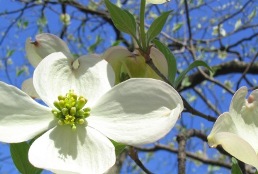Cornus florida 'Appalachian Spring'
Cornus florida ‘Appalachian Spring’ was discovered in Catoctin Mountain Park, Maryland and displayed remarkable levels of resistance to dogwood anthracnose. Resistance of ‘Appalachian Spring’ to anthracnose was confirmed in tests at the University of Tennessee and ‘Appalachian Spring’ clones were released for sale in 1998.
Photo Credit: © Mickaw2 via Wikimedia Commons
Cornus florida 'Appalachian Spring'
Common Name: Appalachian Spring dogwood
Other Common Names: flowering dogwood (cloned)
Plant Functional Group: Deciduous broadleaf
Class > Order > Family: Magnoliopsida > Cornales > Cornaceae
What does the species look like?
Flowering dogwood (Cornus florida ) ‘Appalachian Spring’ is a deciduous, multi-branched shrub or small tree that reaches a height of 20 to 25 feet tall with a crown spreading up to 20 feet. Leaves are opposite, simple, medium green and slightly larger than the native flowering dogwood. Veins are parallel and follow the elliptical shape of the leaf. In the fall, the leaves turn red or purple. The yellow, clustered flowers are inconspicuous and surrounded by four large, showy, white bracts. The fruit is a yellow to red drupe that holds 1 to 2 cream-colored, elliptically-shaped seeds.
Where is the species found?
States & Provinces
AL, AR, CT, DC, DE, FL, GA, IL, IN, KS, KY, LA, MA, MD, ME, MI, MO, MS, NC, NH, NJ, NY, OH, OK, PA, RI, SC, TN, TX, VA, VT, WV
Which phenophases should I observe?
Do you see...?
Leaves
Breaking leaf buds More...
How many buds are breaking?
Less than 3 3 to 10 11 to 100 101 to 1,000 1,001 to 10,000 More than 10,000
Leaves More...
What percentage of the potential canopy space is full with leaves? Ignore dead branches in your estimate of potential canopy space.
Less than 5% 5-24% 25-49% 50-74% 75-94% 95% or more
Increasing leaf size More...
What percentage of full size are most leaves?
Less than 25% 25-49% 50-74% 75-94% 95% or more
Colored leaves Cornus florida 'Appalachian Spring', ignore the red color that leaves growing in full sun develop in the spring or summer. This red pigment develops to protect the leaves from the sun and does not indicate the leaf is dying (senescing).More...
What percentage of the potential canopy space is full with non-green leaf color? Ignore dead branches in your estimate of potential canopy space.
Less than 5% 5-24% 25-49% 50-74% 75-94% 95% or more
Falling leaves More...
Flowers
Flowers or flower buds More...
How many flowers and flower buds are present? For species in which individual flowers are clustered in flower heads, spikes or catkins (inflorescences), simply estimate the number of flower heads, spikes or catkins and not the number of individual flowers.
Less than 3 3 to 10 11 to 100 101 to 1,000 1,001 to 10,000 More than 10,000
Open flowers Cornus florida 'Appalachian Spring', ignore the four large, white bracts and watch for the opening of the small flowers in the center of the bracts.More...
What percentage of all fresh flowers (buds plus unopened plus open) on the plant are open? For species in which individual flowers are clustered in flower heads, spikes or catkins (inflorescences), estimate the percentage of all individual flowers that are open.
Less than 5% 5-24% 25-49% 50-74% 75-94% 95% or more
Fruits
Fruits Cornus florida 'Appalachian Spring', the fruit is berry-like and changes from green to bright red.More...
How many fruits are present?
Less than 3 3 to 10 11 to 100 101 to 1,000 1,001 to 10,000 More than 10,000
Ripe fruits Cornus florida 'Appalachian Spring', a fruit is considered ripe when it has turned bright red.More...
What percentage of all fruits (unripe plus ripe) on the plant are ripe?
Less than 5% 5-24% 25-49% 50-74% 75-94% 95% or more
Recent fruit or seed drop More...
How many mature fruits have dropped seeds or have completely dropped or been removed from the plant since your last visit?
Less than 3 3 to 10 11 to 100 101 to 1,000 1,001 to 10,000 More than 10,000
What do these phenophases look like?
There is currently no photoguide available for this species. If you'd like help us create one, use the guidance document and species template provided here . Then send it via email to education@usanpn.org when it is complete.
